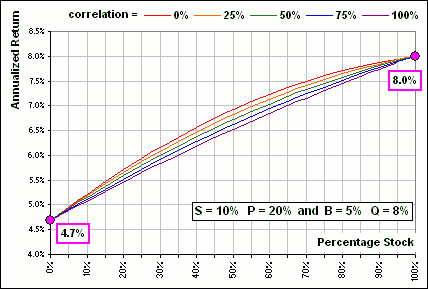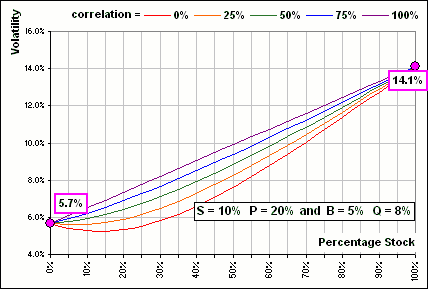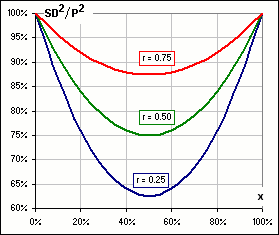| Stocks and Bonds ... again |
Once upon a time I wrote a tutorial on Stocks and Bonds and I went on and on and ...
>Haven't you said that before?
Yes, but I ran across a debate concerning whether annual rebalancing was to decrease volatility or increase returns.
When I looked at those earlier tutorials I saw that
I had missed something that I should point out.
I also found a wee error that I corrected. 
Here we want to recall the following results:
- A fraction x of our portfolio is devoted to the stock component (and y = 1 - x to bonds).
- For the stock component, the Mean Annual Return and Standard Deviation are S and P.
- For the bond component, the Mean Annual Return and Standard Deviation are B and Q.
- The Pearson Correlation between the stock and bond returns is r.
- With annual rebalancing the Mean Annual Return of our portfolio is: M = x S + y B.
- The Standard Deviation SD of our portfolio is given by: SD2 =
x2P2+y2Q2+2 x y r P Q
Note that, as a function of x, this describes a parabola that opens UP - We take as our Annualized Portfolio Return: R = M - (1/2)SD2
See the approximation described in AM vs GM - The Annualized Portfolio Return is then very nearly
R = x S + y B - (1/2){x2P2+y2Q2+2 x y r P Q}
Note that, as a function of x, this describes a parabola that opens DOWN
>And your point is?
My point is that the fractions devoted to stocks or bonds depends upon whether you want maximum annualized return or minimum volatility
and the "best" stock/bond ratio will depend upon the various parameters and ...
>So what's "best"? Don't you have a magic formula?
Yes, it's here:
| for Maximum Annualized Return | Percentage Stock = (S - B + Q2 - r P Q) / (P2+Q2 - 2 r P Q) assuming this lies between 0 and 1 |
| for Minimum Volatility | Percentage Stock = (Q - r*P) Q / (P2 + Q2- 2 r P Q) assuming this lies between 0 and 1 |
>Picture?
Yes. The following charts show the effect of changing the volatility of the stock component:


Here's a calculator:
Then, of course, you may want to sleep well ... and minimize the volatility 


>And how about minimizing volatility and maximizing return ... at the same time?
Yeah, possible ... if the Mean Returns are the same. Try that on the two calculators, above.
>Huh?
Try something like S = B = 10% and P = 30%, Q = 20%.


>And you believe all this stuff?
Of course! Don't you? I mean ... mathematics is an exact science, right? It can't lie! You can place your trust in a mathematical ...
>zzzZZZ
|
Wait! Here's something interesting.
Suppose we have two asset classes, like stocks and bonds, which have identical volatilities ... so P = Q. Then our Volatility (from 6, in the list above) would be: SD2 = x2P2+(1-x)2P2+2 r x (1-x) r P2 = 2P2{ (1-r)x2 - (1-r)x + 1/2 }and, although it gives SD = P when x = 0 or x = 1 (as you'd expect ... 100% asset A or 100% asset B), it has a minimum at x = 0.5 for correlations between 0% and 100% 
| 
|
|
Suppose, too, that the Mean Returns are identical for the two asset. That is: S = B (as well as P = Q).
Then we can do a similar thing with the Annualized Return approximation (from 8, above). R = xS + (1-x)B - (1/2)SD2 = S - P2{ (1-r)x2 - (1-r)x + 1/2 }and, although it gives R = S - (1/2)P2 when x = 0 or x = 1 (as you'd expect), it has a maximum at x = 0.5 for correlations between 0% and 100% ... similar to this 
| 
|
For assets with identical parameters you do better with a 50-50 split than 100% of either.
>zzzZZZ
Can you believe that?
>zzzZZZ
 for a continuation
for a continuation